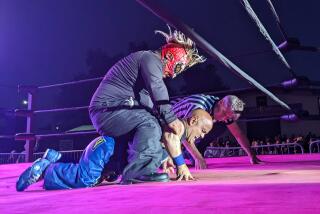‘Little People’ Make Gains in Society but Still Face Problems
- Share via
Dwarfism is one of the most apparent disabilities, yet it is among those receiving the least attention, says Betty Stewart of the Billy Barty Foundation for little people in Orange.
“I think it’s because little people usually don’t want the attention drawn to them because of the heartaches,” said Stewart, a little person who has one son of average stature (6-foot, 2-inch James, age 22) and one son of small stature (4-foot, 2-inch Billy, age 18).
It wasn’t until Billy entered first grade that his size became an emotional issue for him, Stewart said. “That’s when he first discovered that everybody had begun to pass him up in height. He’d come home at night and literally cry and say, ‘I refuse to be little.’ ”
As a parent, she said, “it just tears you apart.”
But Stewart, who is 3 feet, 10 inches tall, would tell her son, “This is the way life is, and the sooner you accept it, the sooner people around you are going to accept it.”
Increasing public awareness about the lives of short-statured people is one reason Stewart opened the Orange County office of the North Hollywood-based Billy Barty Foundation. The nonprofit organization was formed a decade ago by actor Barty with the primary goal of helping short-statured people live more independently and productively.
After little more than a year of operation in Orange County, the foundation has made its presence felt in many ways.
“We get quite a few calls every day,” said Stewart, an Anaheim resident who is volunteer director of the foundation office, situated in the Rehabilitation Institute of Orange.
“The calls are mostly from little people asking about jobs or housing or wanting to know what kind of information we have that we can mail them,” she said. “We’re trying to assist the little person to have a good self-image and be a productive member of society through education and peer counseling, housing referrals, job referrals--just in any way we can.”
Stewart said the foundation also receives calls from physical therapists, psychologists, hospitals, schools and employers from all over the United States requesting information. (Noting that the terms dwarf and midget have a “circus sound to them,” Stewart said, “we try to refer to them as short-statured, or little, people.”)
The foundation also helps parents, relatives and friends in understanding the problems of short-statured people.
“It is a very psychological and emotional drain on the family and friends and everyone,” she said.
Several times a year, Stewart receives phone calls from attorneys and doctors asking if she knows any parents who would be interested in adopting a short-statured child.
“In fact, we just assisted a dwarf couple in adopting a dwarf child,” she said. “The average-statured parents put him up for adoption because they didn’t think they could handle it. These are children that are hard to place as far as adoption agencies are concerned, just like any handicapped child.”
Stewart acknowledged that not all short-statured people want to be labeled handicapped.
“But let’s face it, we are,” she said.
Stewart said many aspects of everyday life that average-statured people take for granted often are insurmountable for little people.
Take pay telephones. “They can’t reach the slot to put the money in,” she said.
Or elevators. “To get up to this office, I have to carry a pencil” to reach the elevator button.
Or cars. They must install special extensions on the gas and brake pedals.
Or supermarket shelves. “Anything above two feet is a problem.”
Finding the right size in shoes and clothing poses difficulties, too, Stewart said. And finding a job often proves to be even harder.
“Most prospective employers don’t take them (little people) seriously,” she said. “They just think every one ought to be in pictures making a fool of themselves.”
The lack of an information and referral center to address the problems of short-statured people spurred entertainer Barty to launch the foundation in 1975.
The 3-foot, 9-inch Barty, 62, whose film credits range from “Gold Diggers of 1933” to “Foul Play,” founded the Little People of America, a nationwide organization for short-statured people and their families, 30 years ago.
Barty, who recently starred in the title role in “Rumpelstiltskin” with Amy Irving and works out of the North Hollywood office as much as he can, said he wanted to “expedite matters concerning people of short stature, whether their needs be medical, psychological, family counseling, vocations (or) educational.”
Stewart said the foundation also donates funds for research into the causes of dwarfism.
Although the U.S. Census does not reflect the number of little people in America, the foundation estimates that 80,000 are born each year.
Dr. David L. Rimoin, director of pediatrics at Cedars-Sinai Medical Center in Los Angeles and director of its Medical Genetics Birth Defects Center, acknowledged that statistics on the number of little people in the United States are poor. At least one person in 1,000 is short because of some disorder, he said.
Stewart said many little people face the prospect of surgery to correct everything from bowed legs to spinal problems.
At 56, she has undergone two hip replacements.
“In our particular type of dwarfism, the joints deteriorate--the bones actually crumble,” she said. “Right now, I’m seeing an orthopedic doctor because my ankles are gone: The ankle bones themselves have deteriorated.”
Stewart said her son Billy has undergone two dozen corrective surgeries on his legs in addition to two major back surgeries.
“There are very few doctors qualified to diagnose dwarfism per se,” Stewart said. ‘My general practitioner knows nothing except what I can feed back to him. It’s not a specialty doctors go into because people know so little about it.”
Dr. Maureen Bocian, a medical geneticist and an assistant professor in the department of pediatrics at UCI Medical Center, said that “understanding the differences between the many kinds of dwarfism is a fairly new science.”
She said there are two main categories of dwarfism: proportionate, in which the arms and legs are in proportion to the trunk, and disproportionate, in which the usual relationships between the length of the limbs and the length of the trunk are not present.
Rimoin noted that the disproportionate type of dwarfism, usually caused by an abnormality of bone growth and development, has more than 100 forms.
Each form of dwarfism has its own cause. “Many of them are genetic; some are hormonal” and each one has its own set of problems, he said.
Rimoin, a leading expert on dwarfism, stressed the importance of making an accurate diagnosis of the specific type of dwarfism to “anticipate and prevent the various complications and be able to offer the families accurate genetic counseling and appropriate therapy (such as growth hormones) if possible.”
Both Bocian and Rimoin praise the work of the Billy Barty Foundation.
“Billy Barty has been very helpful both in forming Little People of America and (through the foundation) raising funds to support our research into the causes of short stature,” said Rimoin, adding that Barty “has been a great role model for many little people to show how well they can do.”
Times generally have changed for the better for little people, Stewart said. “There was a time when they were sort of kept in the closet. Now you have them in every profession. I’m not saying it’s the best it could be, but it’s better than 20 years ago.”
Barty agrees.
“Oh, yes, things have improved,” he said. “But the problem is: The problem is still there. I remember 30 years ago I used to argue with parents--and schoolteachers--not to send their child to a school for handicapped or retarded children. This problem is still evident today. They think the little person would be better off. See, they’re judging the person by their size and not (by) what’s between their ears.”
More to Read
Sign up for Essential California
The most important California stories and recommendations in your inbox every morning.
You may occasionally receive promotional content from the Los Angeles Times.













